Helene and Milton have been added to the list of names of past hurricanes that will conjure up memories of wind, rain, storm surge, power outages and destruction in Southwest Florida.
Time and effort has enabled recovery for some from these devastating storms, but many are still trying to pick up the pieces of their lives while the 2025 Atlantic Hurricane Season looms large.
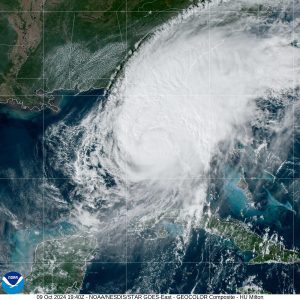
The 2024 Atlantic Hurricane Season in Florida runs from June 1 to Nov. 30. With a history of these storms producing destruction in the region; just the mention of Hurricanes Debby, Helene and Milton (2024), Hurricane Ian (2022), Hurricane Irma (2017), or Hurricane Charley (2004), can bring back dreadful memories.
The Diocese of Venice, and many families, are still recovering from Helene and Milton, as well as Hurricane Ian nearly three years after the storm has passed. However, Bishop Frank J. Dewane said the Diocese of Venice is well-prepared for the coming season.
“The catastrophic impacts of back-to-back hurricanes in 2024, and Ian in 2022, are still fresh in the minds of those who witnessed not only the loss of lives but also the devastating destruction of buildings and livelihoods,” Bishop Frank J. Dewane said. “As a Diocese we do our best to prepare, but it is also important for us to pray for protection from future storms, and also for the people who continue to recover from previous disasters. As the new Atlantic Hurricane Season arrives, let us all ask God for protection and safety.”
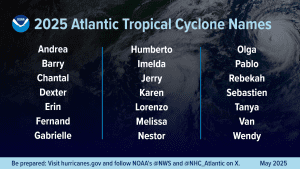 Catholic Charities, Diocese of Venice, Inc., is still on the ground helping families recover from Helene and Milton, as well as Ian, stated Christopher M. Root, CEO of Catholic Charities, Diocese of Venice.
Catholic Charities, Diocese of Venice, Inc., is still on the ground helping families recover from Helene and Milton, as well as Ian, stated Christopher M. Root, CEO of Catholic Charities, Diocese of Venice.
“At Catholic Charities, we’re still walking alongside families who were hit hard by last year’s hurricanes,” Root said. “The headlines may have moved on, but for many, recovery is still happening day by day. We haven’t stopped helping, and we’re also getting ready in case another storm comes our way this season. With support from Catholic Charities USA and a trained disaster response team on the ground in the Diocese of Venice, we’re doing everything we can to be prepared. Whether we’re helping someone rebuild after the last storm or responding to a new one, Catholic Charities is here with compassion, faith, and a real desire to serve.”
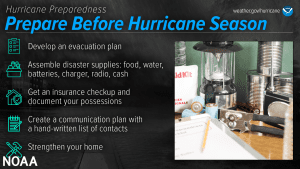 Experts at the National Oceanic and Atmospheric Administration (NOAA) is forecasting a range of 13-19 total named storms (winds of 39 mph or higher), slightly above the seasonal average. This follows the 2024 season which produced 18 named storms, including Hurricanes Debby (Aug. 6-7), Helene (Sept. 26), and Milton (Oct. 9), each of which brought their own misery of wind and rain. Helene, which paralleled the coast, and Milton, whose eye went over Siesta Key, both brought unprecedented storm surges to the barrier islands from Naples in the south through Palmetto to the north. NOAA stated that numerous factors were considered in the forecast, including warmer than average ocean temperatures in the Atlantic Ocean, reduced Atlantic trade winds and less wind shear, all of which tend to favor tropical storm formation, NOAA reported.
Experts at the National Oceanic and Atmospheric Administration (NOAA) is forecasting a range of 13-19 total named storms (winds of 39 mph or higher), slightly above the seasonal average. This follows the 2024 season which produced 18 named storms, including Hurricanes Debby (Aug. 6-7), Helene (Sept. 26), and Milton (Oct. 9), each of which brought their own misery of wind and rain. Helene, which paralleled the coast, and Milton, whose eye went over Siesta Key, both brought unprecedented storm surges to the barrier islands from Naples in the south through Palmetto to the north. NOAA stated that numerous factors were considered in the forecast, including warmer than average ocean temperatures in the Atlantic Ocean, reduced Atlantic trade winds and less wind shear, all of which tend to favor tropical storm formation, NOAA reported.
Weather forecasters and emergency management officials stress that each tropical system is different, explaining that just because you survived Debby, Helene, Milton, Ian, Irma or Charley, without any damage doesn’t mean the next storm, whether it is a tropical storm or major hurricane, couldn’t destroy everything around you.
With many people no longer watching local news, NOAA officials also stress the need for everyone to have access to reliable local weather reports to avoid confusion when a storm approaches. This can be accessed through the National Weather Service, National Hurricane Center, local news outlets or other trustworthy weather sources.
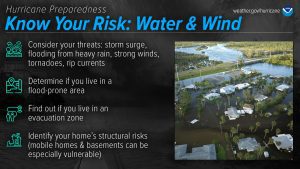
While keeping a wary eye on the weather forecast is important, being prepared before storms approach is just as vital. Preparedness means many things, but a key part is simply knowing where you live in relationship to evacuation zones in your city or county. Also, knowing how well constructed a home is can also impact preparations and planning in the event an evacuation is ordered. Also, as many learned during Helene and Milton, power could be out for days, or weeks, following a storm, and the decision must also be made if one wants to stay under those conditions.
The names for this season, provided by the World Meteorological Organization (WMO), include Andrea, Barry, Chantal, Dexter, Erin and others. The list of 21 names is repeated every six years. The only time that there is a change is if a storm is so deadly or costly that the future use of its name on a different storm would be inappropriate for obvious reasons of sensitivity (Helene, Milton, Ian, Irma, Charley, Katrina, etc.).
If a storm comes
Should disaster strike, Catholic Charities, Diocese of Venice, will be at the forefront in preparing and responding. Catholic Charities will send a team to the epicenter of the disaster and then coordinate to set up relief centers — called PODs, which stands for Points-Of-Distribution – where the need is greatest. These centers – often located at Parishes or next to Catholic Charities offices – will be sites where water, clothing, food and other disaster relief assistance can be distributed. PODs were established at multiple locations following Hurricanes Helene and Milton, with truckloads of water, food and cleaning supplies distributed to needy families.
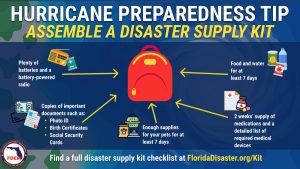
One way people help after a storm is through the Catholic Charities Disaster Rebound Bucket program. These buckets are filled with practical supplies that give families a head start on cleanup and recovery. If you visit CCDOV | Disaster Recovery, you’ll find a short video that shows how the buckets work and an Amazon Wish List for anyone who wants to donate items directly.
As noted earlier, the Diocese of Venice is experienced in responding to these storms. Therefore, each Parish, Catholic school and other entities have hurricane preparedness plans which assist in preparation before a storm and recovery afterwards.
NOAA and emergency management officials remind everyone that taking a few steps now can prevent panic and confusion if a storm were to threaten the area. To track and learn more about hurricanes, visit www.nhc.noaa.gov/.
Being prepared
Emergency management officials emphasize that having an emergency preparedness plan will help lessen the stress on individuals when, inevitably, a new tropical system forms and threatens the region. Key things like knowing your evacuation zone, knowing if your home can withstand forecasted winds, and having emergency supplies and documents ready ahead of time, are key actions to take ahead of the season.
First, officials recommend each family have a Disaster Supply Kit, which should have a minimum of enough water and food to last three to seven days. That means one gallon of water per person/per day, plus enough non-perishable food that does not require electricity to prepare and consume safely. Those who care for infants or the elderly must plan for what specialty items will be needed.
Other key items for a Disaster Supply Kit include clothing (rain gear and sturdy shoes), blankets/pillows, first aid kit, all medicines and prescription drugs, toiletries, flashlights, battery-operated radio, cash, important documents in a waterproof container, and any items for your pets.
If a storm were to strike, getting basic supplies will be a challenge. The Federal Emergency Management Agency stresses that in the aftermath of a major disaster, you should expect to be on your own for at least three days, if not longer, before substantial state and federal resources can be expected. If you have a Disaster Supply Kit that went unused in 2024, inspect it to ensure all items are fresh and the batteries are still good.
Those who have medical or transportation issues must contact their city/county Emergency Management Office (the number is available online or you can dial the non-emergency 511), to register and to potentially be relocated to a shelter if a storm threatens. This registration must be done annually.
Another key action is to make sure any insurance is up-to-date, and photographs are taken of all valuables before the storm. Keep in mind that hurricane and flood insurance will take a minimum of 30 days to go into effect.






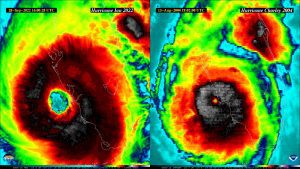
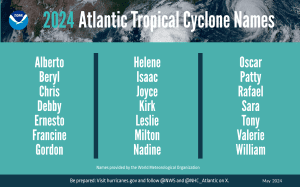

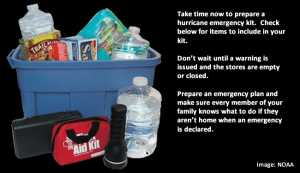
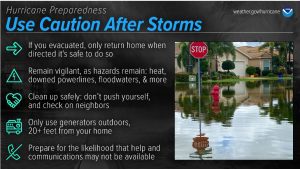
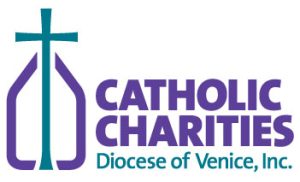
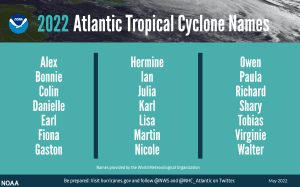 One only has to see how Hurricane Agatha, a storm that formed in the Pacific Ocean, slammed the Mexican coastline during Memorial Day Weekend before crossing and heading into the Gulf of Mexico just in time for the official opening of the 2022 Atlantic Hurricane Season.
One only has to see how Hurricane Agatha, a storm that formed in the Pacific Ocean, slammed the Mexican coastline during Memorial Day Weekend before crossing and heading into the Gulf of Mexico just in time for the official opening of the 2022 Atlantic Hurricane Season.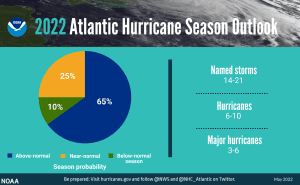 “As we reflect on another potentially busy hurricane season, past storms — such as Superstorm Sandy, which devastated the New York metro area ten years ago — remind us that the impact of one storm can be felt for years,” said NOAA Administrator Rick Spinrad, Ph.D.
“As we reflect on another potentially busy hurricane season, past storms — such as Superstorm Sandy, which devastated the New York metro area ten years ago — remind us that the impact of one storm can be felt for years,” said NOAA Administrator Rick Spinrad, Ph.D.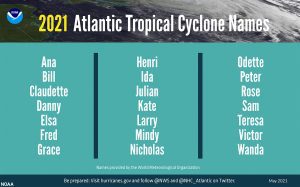 The 2021 Atlantic Hurricane Season has yet to officially begin (June 1-Nov. 30), yet there has already been one named storm – Tropical Storm Ana. This is the seventh year in a row that a there has been an early named storm. While Ana was never a threat to the Diocese of Venice, it serves as a not-so-subtle reminder that these ferocious storms can form at any time and early preparation is the key to safety and survival.
The 2021 Atlantic Hurricane Season has yet to officially begin (June 1-Nov. 30), yet there has already been one named storm – Tropical Storm Ana. This is the seventh year in a row that a there has been an early named storm. While Ana was never a threat to the Diocese of Venice, it serves as a not-so-subtle reminder that these ferocious storms can form at any time and early preparation is the key to safety and survival. Father Rafal Ligenza, Administrator of St. Joseph Parish in Bradenton was sworn in as U.S. Citizen on July 6, 2020. A native of Poland, Father Ligenza was ordained to the priesthood in 2011 for the Diocese of Venice by Bishop Frank J. Dewane. Father Ligenza has been Administrator at St. Joseph Parish since January of 2019 and previously served as Parochial Vicar at St. William Parish in Naples and St. Columbkille Parish in Fort Myers. Congratulations Father!
Father Rafal Ligenza, Administrator of St. Joseph Parish in Bradenton was sworn in as U.S. Citizen on July 6, 2020. A native of Poland, Father Ligenza was ordained to the priesthood in 2011 for the Diocese of Venice by Bishop Frank J. Dewane. Father Ligenza has been Administrator at St. Joseph Parish since January of 2019 and previously served as Parochial Vicar at St. William Parish in Naples and St. Columbkille Parish in Fort Myers. Congratulations Father!

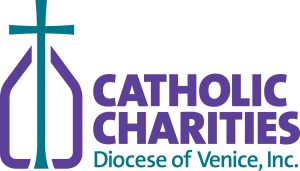 If you need assistance from Catholic Charities for food, financial assistance or tele-mental health counseling, please call the number for your area listed below 9 a.m.-5 p.m., Monday-Friday. Services have expanded to include assistance in applying for state and federal benefits if you have lost work due to the COVID-19 Pandemic:
If you need assistance from Catholic Charities for food, financial assistance or tele-mental health counseling, please call the number for your area listed below 9 a.m.-5 p.m., Monday-Friday. Services have expanded to include assistance in applying for state and federal benefits if you have lost work due to the COVID-19 Pandemic:
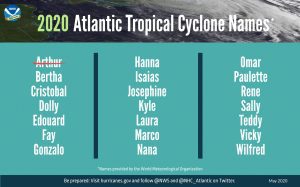 As the 2020 Atlantic Hurricane Season continues (June 1-Nov. 30), a prayer is presented here by which one asks God for protection and safety from the storms that often threaten Southwest Florida. With the formation of Tropical Storm Arthur in med-May, it promises to be another busy season of watching the tropics. We must all remember the devastating effect of Hurricane Irma from 2017 and what was witnessed when Hurricane Michael struck the Florida Panhandle in 2018, everyone in the Diocese of Venice knows and understands the power of these storms and the suffering which follows in their wake.
As the 2020 Atlantic Hurricane Season continues (June 1-Nov. 30), a prayer is presented here by which one asks God for protection and safety from the storms that often threaten Southwest Florida. With the formation of Tropical Storm Arthur in med-May, it promises to be another busy season of watching the tropics. We must all remember the devastating effect of Hurricane Irma from 2017 and what was witnessed when Hurricane Michael struck the Florida Panhandle in 2018, everyone in the Diocese of Venice knows and understands the power of these storms and the suffering which follows in their wake.